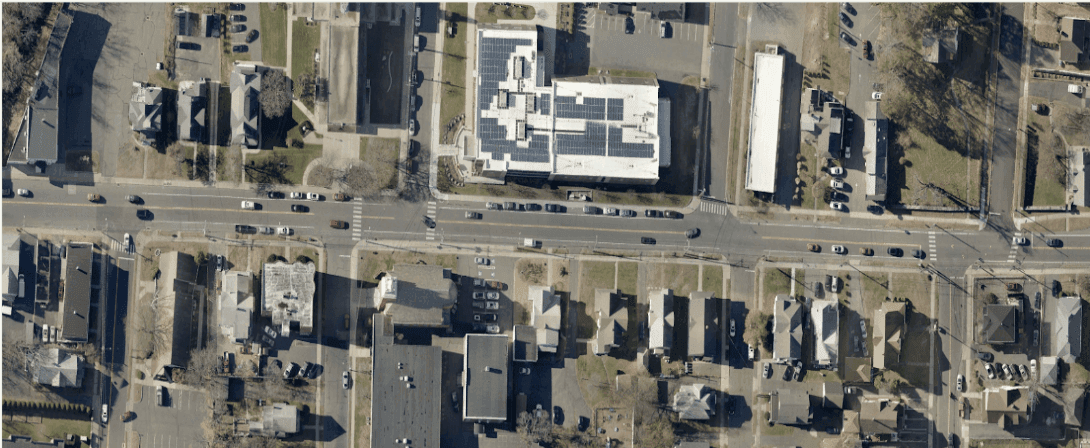
News
By Eric Cova, March 20, 2024
Bristol has made commitments to Complete Streets in the past as a strategy to confront their lack of biking and walking infrastructure. With major state routes running through its borders, the Bristol team was eager to collaborate directly with CTDOT in the program so that they could learn how to make their roads safer for all users—and create a roadmap for other cities to do the same. Read the full case study in the Complete Streets Leadership Academies Report and explore the other case studies here.
Project Snapshot
From the program’s launch, Bristol had a clear idea of where they wanted to deploy their quick-build demonstration. The site covered several blocks on West Street (CT 69), home to key community destinations including Immanuel Lutheran School, the Boys and Girls Club, and St. Stanislaus Roman Catholic Church, making it a place that draws more pedestrians. However, the offset crosswalks and frequent parking made it a challenging place for pedestrians to cross and otherwise get around.
Bristol temporarily removed one of the existing offset crosswalks and installed a temporary perpendicular crosswalk to encourage crossings at a single location to make it more clear to drivers to yield to people walking. They also improved visibility for both drivers and people on foot at the intersections by removing the capability to park at corners. The team worked with community members— including the Boys and Girls Club—to host a launch event in September where they solicited feedback and celebrated the temporary changes.
Outcomes
The impact of the project was measured through observations, data collection, and engagement. One highlight from their findings was that speed data confirmed that the travel speeds were reduced during the installation, from approximately 38 miles per hour pre-installation to approximately 29 miles per hour at the end of the installation period.
Key Takeaways
Community connections are key. When making changes, it is important to think about who will be the most impacted by them and make an effort to include those groups in the process from start to finish. This will not only help create a better project that improves the community but also builds trust within the community and can ultimately lead to more community support and involvement in future efforts. In Bristol, the city made sure to do a lot of outreach in preparation for the quick-build demonstration and held a launch event that allowed the community to interact with the changes and give their feedback.
Strong collaboration equals success. When embarking on a project, it’s critical to connect with all the partners as early as possible whether they are local community groups, city or county staff, or those from a state department of transportation. Bristol found experiences interacting with CTDOT and transportation professionals from other cities extremely valuable, especially when they were able to connect in person.
Keep the momentum going. Coming out of the Complete Streets Leadership Academy, Bristol was figuring out what the project meant for long-term change. Quick-build projects are useful tools to test out potential infrastructure improvements without investing tons of funding and to make sure they work for the community before putting in something permanent. When implementing a quick build, start thinking of ways to use the lessons learned to plan for future permanent investments in transportation safety.
 In 2022, Smart Growth America launched the Complete Streets Leadership Academies in Alaska, California, Connecticut, and Tennessee to equip and train local agencies and state departments of transportation to collaborate, innovate, and commit to making changes together to address safety on these dangerous state-owned roads. Cohorts were selected to plan and implement "quick-build" demonstration projects, a way to pilot and test new ideas and street designs to activate streets and better support walking, biking, and rolling.
In 2022, Smart Growth America launched the Complete Streets Leadership Academies in Alaska, California, Connecticut, and Tennessee to equip and train local agencies and state departments of transportation to collaborate, innovate, and commit to making changes together to address safety on these dangerous state-owned roads. Cohorts were selected to plan and implement "quick-build" demonstration projects, a way to pilot and test new ideas and street designs to activate streets and better support walking, biking, and rolling.This program and report was developed with funding from the Centers for Disease Control and Prevention’s (CDC) Division of Nutrition, Physical Activity, and Obesity (Cooperative Agreement CDC-RFA-OT18-1802). The views presented in this product do not necessarily reflect the views and/or positions of CDC.
Related News

© 2025 Smart Growth America. All rights reserved
Site By3Lane Marketing




























